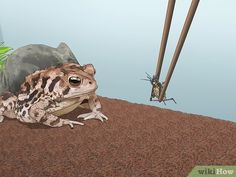How to Care for a Toad

Toads, also known as the Anura order of amphibians, are fascinating creatures that can make unique and interesting pets. These low-maintenance animals can bring joy to their owners, but it’s essential to provide them with the appropriate care and environment. This article will discuss how to care for a toad, including habitat, diet, safety concerns, and other essential care tips.
1. Setting Up the Habitat
To care for your toad, you’ll need to create a suitable habitat that closely mimics its natural environment. Consider the following when setting up your toad’s enclosure:
– Tank Size: Choose an appropriately sized tank or terrarium based on the size and number of toads. A 10-gallon tank is a suitable size for one to two small- or medium-sized Toads.
– Substrate: Line the bottom of the tank with a safe substrate like coconut fiber or sphagnum moss. Avoid using gravel or sand as these can cause injury or impaction if ingested.
– Hiding Spots: Provide various hiding spots such as hollow logs or cork bark pieces for your toad to seek refuge and feel secure.
– Water Source: A shallow dish of water should be provided in the enclosure for your toad to soak in. Make sure it is not too deep, as this may cause drowning.
– Humidity: Toads require a humid environment—aim for about 60–70% humidity. Achieve this by misting the enclosure with water daily or using a fogger system.
– Temperature: A gradient temperature is essential in an enclosure where one side is slightly warmer than the other. The warmer side should be around 75–80°F (24–27°C), while the cooler side can be between 65–70°F (18–21°C).
2. Feeding Your Toad
Toads are carnivorous and will eat a variety of insects. To maintain a healthy diet, consider the following tips:
– Staple Diet: Offer a mixture of insects such as crickets, mealworms, and earthworms.
– Variety: Avoid feeding only one type of insect to prevent any nutritional deficiencies.
– Calcium Supplements: Dust the insects with calcium powder to ensure your toad gets essential nutrients.
– Feeding Schedule: Feed adult toads three to four times a week and juvenile toads daily. Adjust the feeding schedule based on your toad’s age and their willingness to eat.
3. Handling and Safety Concerns
While it’s tempting to handle your new pet frequently, resist this urge. Toads have delicate skin that can be easily damaged by human hands. Moreover, our hands can also transfer harmful chemicals or bacteria to them. Always wash your hands before and after handling your toad, and handle them gently and for short periods when necessary.
4. Ongoing Care
To ensure the health and happiness of your pet, perform regular maintenance on their habitat:
– Cleanliness: Spot clean daily by removing uneaten food or waste products from the tank. Perform a thorough cleaning of the enclosure at least once a month.
– Monitor Health: Observe your toad closely for any changes in its appearance or behavior that may indicate illness. Consult an experienced vet specializing in amphibians if necessary.
By following these simple guidelines and being attentive to the needs of your pet, you can create a comfortable and healthy home for a toad. Make sure you research specific care requirements depending on the species you choose as different types of toads may have varying needs but this basic guide should serve as a starting point on how to care for these incredible creatures.





